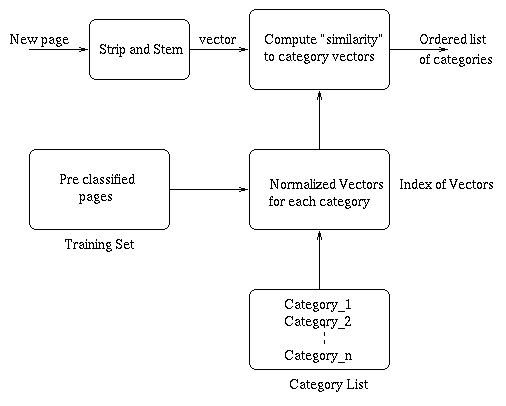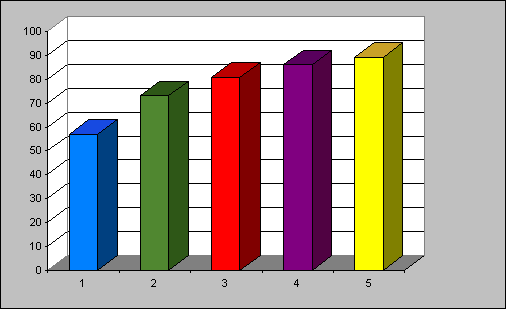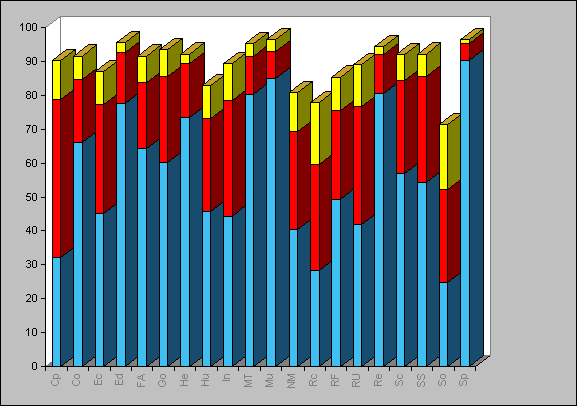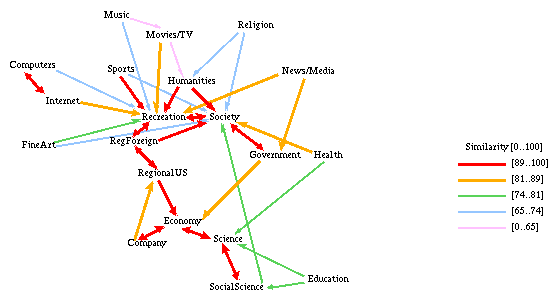

We study the automatic classification of Web documents into pre-specified categories, with the objective of increasing the precision of Web search. We describe experiments in which we classify documents into high-level categories of the Yahoo! taxonomy, and a simple search architecture and implementation using this classification. The validation of our classification experiments offers interesting insights into the power of such automatic classification, as well as into the nature of Web content. Our research indicates that Web classification and search tools must compensate for artifices such as Web spamming that have resulted from the very existence of such tools.
In fact, all currently available search tools suffer either from poor precision (i.e., too many irrelevant documents) or from poor recall (i.e., too little of the Web is covered by well-categorized directories). We address this by developing a search interface that relies on the automatic classification of Web pages. Our classification builds on the Yahoo! taxonomy, but differs in that it is automatic and thus capable of covering the whole Web substantially faster than the (human-generated) Yahoo! taxonomy. We describe experiments with our classifier; these tell us a great deal both about the particular classification implemented by Yahoo! as well as a great deal about the nature of Web content. In particular, we draw inferences on how the presence of search engines is influencing the content of Web in interesting ways that pose challenges to statistical classifiers such as ours, by studying the effect of Web spamming [NYT96] on our classification.
Yahoo! for example consists today of a classification tree of depth of 10 or more (depending on the path followed). About 10-30 branches at each level of the tree lead to a total of a few hundreds of thousands of pages. Search in a net directory is very convenient and usually leads the user to the set of documents he is seeking, but it leads to only a small fraction of the Web (often the commercial part). This limited coverage stems from the (slow) rate of manual classification.
Search engines such as AltaVista and Excite cover a large portion of the Web. The drawback of these search engines is that they support only syntactic, keyword-oriented search, i.e., the search returns a list of pages that include a given set of keywords (or phrases). Most queries return either no page or a long list of pages, all of which include the given keywords, but most of which are irrelevant. The user must manually browse one document after another to find the page(s) sought. Some search engines offer "advanced" search features that enable Boolean combinations of search terms for improving the precision of the search. Aside from the limited improvement this can afford, one should not expect non-computer-literate users (whose ranks are growing) to be experienced at forming such Boolean formulae. (Note also that the "find similar pages" features in Excite and Infoseek require the user to first find at least one relevant page using syntactic search).
To implement this idea we need an automatic process that accurately classifies Web pages. This process must be as efficient (in terms of time and space) as the process of building the index tables for the syntactic search engine. We describe here a prototype that achieves these goals. We then describe experiments we performed to develop this prototype, the validation of the automatic classification, and the inferences one may draw from these experiments on the power of automatic classification and the Yahoo! directory.
In Section 2 we give a high-level description of the components of our search architecture. Section 3 describes the particulars of the experiments with Yahoo! used for our prototype. In Section 4 we draw inferences (based on our experiments) concerning the vocabulary of the Yahoo! taxonomy, and the effects of Web spamming, a direct result of the existence of Web search engines.

Figure 1 - Classification Overview

Figure 2 - Search Architecture
We use a random sample of 2000 documents from each of the following 20 high-level Yahoo! categories to train our automatic classifier. Note that our categories do not exactly match the Yahoo! categories, as we chose to break several large topics into separate categories. Table 3 explains how we chose to form each of our categories from the top two levels of Yahoo!. After using these pages to train our classifier, we evaluated its performance by testing it against a new set of 500 randomly selected documents from each of the categories (not including documents used in the training phase). For both the training and classification we stripped the pages of their html tags but we did not stem the words. We believe that stemming will considerably improve the results. We used an inverted index to store the vectors for each category.
| ID | Our Category | Relative to Yahoo! |
|---|---|---|
| Cp | Companies | Business_and_Economy:Companies, Business_and_Economy:Products_and_Services |
| Co | Computers | Computers_and_Internet (without Internet) |
| Ec | Economy | Business_and_Economy (without Companies, Products_and_Services) |
| Ed | Education | Education |
| FA | Fine_Arts | Arts (without Arts:Humanities) |
| Go | Government | Government |
| He | Health | Health |
| Hu | Humanities | Arts:Humanities |
| In | Internet | Computers_and_Internet:Internet |
| MT | Movies_TV | Entertainment:Movies_and_Films, News_and_Media:Television |
| Mu | Music | Entertainment:Music |
| NM | News_and_Media | News_and_Media (without Television) |
| Rc | Recreation | Entertainment, Recreation (without Movies_and_Films, Music, Sports) |
| RF | Regional_Foreign | Regional:Regions, Regional:Countries |
| RU | Regional_US | Regional:U.S._States |
| Re | Religion | Society_and_Culture:Religion |
| Sc | Science | Science |
| SS | Social_Science | Social_Science |
| So | Society_and_Culture | Society_and_Culture (without Religion) |
| Sp | Sports | Recreation:Sports |
Table 3 - Our Twenty Categories
Once trained, the classifier outputs an ordered list of possible categories for any given document. Assuming that the Yahoo! classification for that document is the "correct" one, we check the rank of that category in the list of categories generated by the classifier for that document. In Figure 4, we plot the recall percentage for various values of cutoff. That is, for a given cutoff value k, we assume that a document is correctly classified if its Yahoo! category is in the first k categories in the list. In more than 50% of the documents tested the Yahoo! classification came up first in the output of the automatic classifier, in more than 80% of the documents the Yahoo! classification was among the top 3 categories, and in more than 90% of the documents it was among the top 5 categories. Thus, for example, if a typical document were associated with 5 categories, the syntactic search would focus on a smaller and more focused subset of the Web (in the absence of classification, we may instead think of all documents being classified under all 20 categories). These results indicate that our automatic classifier can enhance syntactic Web search; more on this below.

Figure 4 - Overall Recall Percentages for Cutoffs 1 to 5

Figure 5 - Individual Category Recall Percentages for Cutoffs 1, 3 and 5
The quality of the classification process depends on the degree of "separation" between the categories used in the training process. This separation between categories depends on two factors:

Figure 6 - Nearest Neighbors of our Categories
The graph clearly identifies categories that are well isolated from any other categories (e.g., Music and Religion) and pairs or groups of categories that are inherently close to each other and thus cause ambiguity in classification (Computer and Internet; Companies and Economy).
| Category | Top Ten Most Discriminating Words |
|---|---|
| Companies | lessons, instruction, cars, driver, golf, photography, recording, classic, products, customers |
| Computers | linux, protocol, applet, bbs, os, modem, nt, shareware clock, comp |
| Economy | resume, jobs, models, fashion, ads, employment, consulting, marketing, investment, sales |
| Education | admissions, aid, loan, admission, financial, teachers, teacher, student, curriculum, learning |
| Fine_Arts | dance, theatre, artist, art, artists, architecture, photography, gallery, amateur, arts |
| Government | dole, republican, election, senate, democratic, campaign, vote, party, congress, gov |
| Health | patients, clinical, syndrome, cancer, therapy, surgery, disease, treatment, drug, medicine |
| Humanities | genealogy, novel, son, looked, anne, battle, poetry, fiction, war, texts |
| Internet | loser, irc, vrml, chat, cgi, translation, channel, domain, script, perl |
| Movies_TV | qv, jurassic, wars, trek, episode, movie, star, cast, film, hollywood |
| Music | jazz, album, guitar, band, bands, songs, concert, midi, song, blues |
| News_and_Media | cnn, clinton, fm, newspaper, radio, officials, trial, said, broadcast, mars |
| Recreation | oz, wine, cards, fish, game, glass, amateur, moon, magic, players |
| Regional_Foreign | india, kong, hotels, islands, hotel, russia, asia, bus, irish, tel |
| Regional_US | malls, hurricane, mn, homes, hawaii, breakfast, mexico, estate, carolina, il |
| Religion | christ, worship, bible, church, jesus, ministry, prayer, jewish, holy, faith |
| Science | maui, physics, dogs, dog, psychology, engineering, mathematics, surface, satellite, laboratory |
| Social_Science | adj, ion, anthropology, au, pl, economics, criminal, vs, studies, justice |
| Society_and_Culture | gay, lesbian, recipes, sexual, sex, gender, abuse, police, crime, lead |
| Sports | hockey, coach, olympic, baseball, league, football, teams, ball, team, sport |
Table 7 - Top 10 Distinguishing Words
Examining the list of key words, we find many interesting entries. Our lack of stemming manifests itself, for instance, with the occurrence of both "admission" and "admissions" in Education, or "artist" and "artists" in Fine_Arts. We also notice several abbreviations, such as "il", "mn", and "tel". Many of these effects could be remedied with the use of stemming and dictionaries, however it is not so clear that all of these should be eliminated. Clearly, many abbreviations such as "os," "nt," and "irc" offer important information to a classifier about the origin of a document. Stemming algorithms developed in information retrieval for more structured documents, like news and scholarly articles, need to be adapted to handle web documents.
Furthermore, we notice several anomalies. Why is the term "maui" the most distinguishing term in our list of keywords in the Science category? Why is the term "loser" the most distinguishing term in the Internet category? We next consider these and other artifacts resulting (in our opinion) from the great diversity of authorship and content on the web. There is a wide range of document length and quality on the web. Inevitably, certain measures must be taken to minimize the skew and bias in our classification procedure that a small number of documents may introduce. Variation in length is addressed by the following classical technique: the frequency of words in a given document is normalized to eliminate bias from documents that are substantially longer than the rest. However there are other, more pernicious sources of difficulty that a classifier used to support web search must be resilient to; curiously, these difficulties are a direct consequence of web search engines.
In fact, up to 1000 of the 40000 Yahoo! pages that we chose for our training set seem to employ a variant of such Web spamming. For this reason, it is important to consider the effects of these pages on our automated classification. The effects of such pages can certainly be seen in our experiment. For example, in our list of words which most notably identify a page as "Science," we find that the top word is "maui." This seems surprising, and it turns out that our training set contains a page chosen from Science:Ecology at Yahoo!, titled "Maui Institute." This page simply discusses how nice the weather is every day in Maui, and hence the ontologists at Yahoo! agreed to list this page in its Science taxonomy. However, at the bottom of this page are 627 repeated occurrences of the words "maui golf real estate" making up 2500 of the 2700 words in the document, substantially affecting our classifier's view of science.
Not surprisingly, we found such techniques used commonly in commercial sites from our training set. In the Company category, we found single documents with repetitions of the following words: pinball (137 repetitions), rolex (308), cars (486), skateboards (525), lighting (540), and golf (1010). Another site stuffed their document with repetitions of several words, the only one of which we can print is adult. Furthermore, this technique was not limited to commercial sites. We found that a university department had placed 127 repetitions of their department name in the title of their page (they have since removed them). Similarly, a medical school trauma center stuffed their page with 164 occurrences of the word trauma, comprising over 75% of the document. A student named Sean, apparently preparing for the job market, stuffed his page with 140 occurrences of his name, along with many other keywords identifying his field. Patriotism was big, with several tourism groups spamming the words: Iran, India, and Kenya. We found a bit of political activism, with 121 occurrences of the words teen and protest repeated in a page about teen curfews in Florida. Even the government chipped in, as a department of the National Weather Service decorated its page with 83 sprinkled occurrences of the word snow. The absolute winner in terms of quantity was the Relief Network page, devoted to helping us all recover from addictions, while habitually stuffing their own page with 2976 occurrences of the word free, along with several hundred occurrences of the words smoking, drug, improvement, addiction and others.
Although many such pages appeared in our training set, the results of our experiments reveal that the influence of such pages has a rather limited effect on our ability to classify other pages. The possible effects of such bias are discussed in Section 4.3, and methods for limiting such bias are suggested in Section 5.
We outline here a number of improvements that may lead to better classification.
As with any sampling-based technique it is important to tailor the sampling technique to minimize sampling error and bias. Two sources of bias already mentioned are: (1) very long documents; and (2) spamming. The effect of long documents is controlled by measuring the frequency of a word in a document, rather than the number of times it appears in the document. Spamming can be controlled by limiting the ``weight'' of any single document in the outcome. A third source of bias is ``missing documents''. In collecting the sample documents one cannot ignore documents that are not accessible quickly (e.g., documents outside North America) when requested by the sampler. This could bias the sample, giving more weight to large, domestic sites. One can compensate for ``missing documents'' using standard missing-data sampling techniques.
As the precision of the classification improves one can aim at a more refined classification, discriminating between hundreds of different categories. As in Yahoo!, such a classification can be built hierarchically. Using stratified sampling a classifier can be trained for a large number of sub-classes using a relatively small number of sample documents.
As mentioned before, stemming can lead to better training and classification of documents. Scanning non-html documents (or parts of documents) such as imagemaps or frames for text can also help in classifying documents. Finally studying the links connected to and from a document could improve the accuracy of classifying that document.
[FB92]
Information retrieval: data structures and algorithms.
William B. Frakes and Ricardo Baeza-Yates. Prentice Hall, Englewood Cliffs, N.J., 1992.
[KB95]
Subject-based searching using automatically extracted metadata - the
AIM subject prototype.
T. Kirsche and R. Barrett.
IBM Research Report , Oct. 27, 1995,
[NYT96]
Desperately Seeking Surfers; web programmers try to alter search
engines' results,
Laurie Flynn,
New York Times, Nov 11, 1996, p. C5.
[SM83]
Introduction to modern information retrieval.
Gerard Salton and Michael McGill. McGraw-Hill, New York 1983.
[vanR79]
Information Retrieval.
C.J. van Rijsbergen.
Butterworths, London 1979.
Return to Top of Page
Return to Posters Index